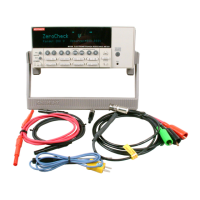3-20 Remote Operation Model 6517A Getting Started Manual
Arming the instrument to respond to triggers is implicit in the non-SCPI instruments. Sim-
ply sending a command to a non-SCPI instrument to change any of the trigger controls
causes the instrument to arm itself for triggers.
The SCPI trigger model implemented in the Model 6517A gives you:
• Explicit control over the trigger source (the TRIGger subsystem).
• A two-level control for arming the instrument for triggers.
• A way for completely disabling triggers.
Changing any of the settings in the TRIGger subsystem does not automatically arm the
Model 6517A for triggers.
The following program sets up the Model 6517A to take one reading each time it receives
an external trigger pulse.
'Example program to demonstrate one-shot external triggering
'For QuickBASIC 4.5 and KPC-488.2/CEC interface card
'Edit the following line to where the QuickBASIC
'libraries are on your computer
'$INCLUDE: 'c:\qb45\ieeeqb.bi'
'Initialize the interface as address 21
CALL initialize(21, 0)
'Reset controls in INIT, ARM;LAY1, ARM:LAY2, and TRIG subsystems
'and put trigger model in IDLE state
CALL SEND(27, "*rst", status%)
CALL SEND(27, "trig:sour ext;coun inf", status%)
'start everything
CALL SEND(27, "init", status%)
After the Model 6517A receives the INITiate command, it stops in the TRIGger layer
of the trigger model, waiting for a pulse on the external trigger jack. Each time a pulse
arrives on the external trigger jack, the Model 6517A takes one reading. Because
TRIGger:COUNt has been set to INFinity, the trigger model never exits from the
TRIGger layer. You can send the ABORt command to put the trigger model in the idle
state, disabling triggers until another INITiate command is sent.

